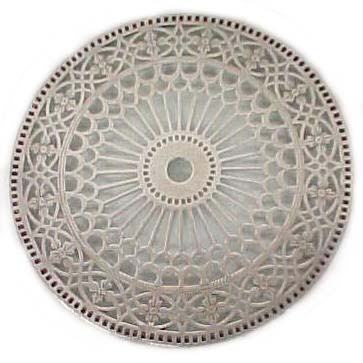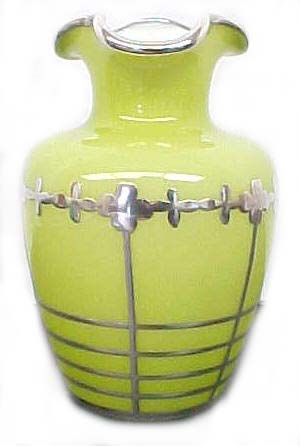



Silver has been used to decorate bronze, copper, and earthenware for ages. Silver on glass, however, started to come into its own a little over a century ago.
In 1889 Oscar Pierre Erard of Birmingham, England developed an effective method of electroplating silver on glass and porcelain. Although beautiful on the outside, it shared an important shorcoming with its predecessors. The reverse side of the silver design, the side next to the glass would tarnish and turn dark. In clear plates, bowls, dishes and glasses this unsightly result was hardly condusive to a hearty appetite.
In 1893, an American from New Jersey by the name of John H. Scharling patented a method no less simple or beautiful than Erard's creation, but with a distinct advantage. The reverse side of the design was snow white and it stayed that way indefinitely. Like Erard's method, Sharling's designs utilized electroplating.
He shared his new process withall, both domestic and European. By 1895, the Czechs, Italians, French, English and Austrians were producing exciting glassware with sterling deposit and overlay. Not to be outdone, US makers began producing copiously.
From 1895 to the late 1920s, this elegant and exciting manifestation of the glassmaker and silversmith’s art garnered its own avid following, just short of becoming a decorative rage. Silver overlay and silver deposit were regarded as an exquisite, special gift or accent for that certain table or shelf. A few nice pieces of overlay were as evident in the genteel home as a piano in those days of refined, yet simple pleasures.
The Great Depression caused many of the glass companies to either go out of business or resort to specializing in cheaper, more affordable glassware.
The era of expensive sterling silver applied to glass was all but over and not may pieces can be found that were manufactured after the mid-1930s.
Today, most examples have disappeared into private collections and museums, but occasionally you can find that special piece for either yourself or an especially deserving and discriminating recipient.
Here are the answers to actual questions from customers and collectors:
Q: I’m a little confused. Isn’t silver overlay and silver deposit the
same thing?
A: Yes and no. Originally because the manufacturers around the turn
of the century used the “overlay” and “deposit” interchangeably, they were
thought to be the same thing. Purists, however, argue that, because there
are subtle differences in the manufacturing processes and the fact that
‘overlay’ is usually always ‘thick’ whereas ‘deposit’ is usually always
‘thin’, that a specific differentiation should be made. (I have a tendency
to agree with the purists). There is a pamphlet masquerading as a book
on silver ‘overlay’ which features on the cover, in color, a fine example
of silver ‘deposit’. So I guess people can suit themselves as to the terminology.
Q: Is it a chore to keep clean and doesn’t it tarnish something fierce?
A: Actually, with our modern anti-tarnish silver creams, an initial
cleaning is all that’s required. If you follow the directions, all you’ll
need is a little touch up once a year (My favorite polish is Hagerty’s
Silversmith’s Polish with R22 tarnish preventative in the blue plastic
bottle, and no, I don’t own stock in the company!) Later, say to 1925 to
1935, domestically made silver overlay pieces had a rhodium treatment at
the factory and need no polishing whatsoever.
Q: I love the looks of silver overlay and deposit but how can I get
started? What’s good and what’s no so good?
A: As with most art, let your own sense of taste be your guide. Pick
out a piece that you like and that you can display in a special place or
use for special occasions or guests. I f you can find a massed display
of silver on glass, it makes choosing much easier because then you don’t
have to scour the entire state to find a half dozen examples.
Q: I have a faorite aunt who is crazy about Venetian glass and I wonder
if the Italians ever made any Venetian glass with silver?
A: You can find some nice examples of silver deposit on Venetian glass;
usually in the form of decanter sets or small to medium sized vases. They
will be from Murano, however, which is a sister island in the Venetian
lagoon. Venice moved its legendary glassworks to Murano at the end of the
thirteenth century as a fire prevention measure and also to hide their
manufacturing secrets from prying eyes.
Q: I love Czechoslovakian art glass but can’t remember seeing any with
silver decorations. Have they made any silver deposit or overlay?
A: I could name a dozen famous deceased Czech artisans who are at this
moment turning over in their graves at this question. The answer is Yes,
Yes, and Yes! Some of the most magnificent silver work on glass is the
late nineteenth and twentieth century Czech. The problem is that over the
years the intricate silver designs have tarnished and now appear as black
or copper colored paint. All they need is a thorough and careful cleaning
to release the hidden beauty. I once sold a cobalt vase made by a renowned
Czech artist of generations past. It was represented to me by an East Coast
dealer as being ”copper overlay deposit” (whatever that is). When I returned
to Washington, five minutes with a sponge and polish resulted in an amazing
transformation. I had personally turned copper into silver! Imagine that.
Q: I have a couple of nice serving plates with silver overlay and would
like to use them for special occasions. But I’m scared I’ll ruin them.
What should I do?
A: Nothing enhances a sit down dinner like elegant serving plates and
platters. Feel free to use them if you follow these simple rules:
1. Never cut anything on the plate. Pre slice meats or breads beforehand.
2. Never serve eggs or egg products. The high sulfur content wreaks
havoc.
3. Never, never use the dishwasher! Wash and rinse by hand in warm
water and mild detergent.
4. Always rinse off silver polish. Digestion is not aided by ingesting
silver polish.
Q: I love the looks of silver overlay and deposit and would like to
start a collection. Should I start now and are prices likely to go up or
down?
A: Collecting art as an investment is always a dicey proposition and
should be the province of the very rich or the very knowledgeable. Buy
what you like personally and let the chips fall where they may. Prices
in the more populous areas of the country are already skyrocketing on silver
deposit and overlay. My guess is, in as little as a year from now, the
prices we’re paying in the Northwest today will seem cheap indeed by comparison.
Q: I have inherited an extremely delicate piece of Florentine glass
with somewhat worn and thin silver deposit. I would like to clean the silver
but I’m afraid a commercial silver cleaner would be too abrasive. I don’t
want the silver design to disappear because it is breathtaking. What can
I do?
A: Here is my pet recipe for a super mild silver cleaner:
1 teaspoon cigarette ashes
1/8 teaspoon corn starch or flour
3/4 teaspoon water (or more)
1/8 teaspoon Hagerty’s (blue bottle) anti tarnish paste.
Mix into a thin paste, adding more water if necessary. Apply thinly
to silver- do not rub!- and let dry. After drying, polish ever so gently
with a terry towel. Repeat as many times as needed.
Q: Why are some of the silver patterns the same on the two different
brands of glassware (i.e., Heisey or Fostoria)?
A:Most glassmakers did not have their own silver department. Fostoria
was a notable exception. Fostoria also had silver work done by outside
silversmiths and did indeed do a limited amount of silver work for other
glass makers in their own shop. Although a few of the silver companies
survive to this day, many also fell by the wayside during the Great Depression
or shortly thereafter.


Shop for Silver Overlay and 16,500 other antiques on our website: